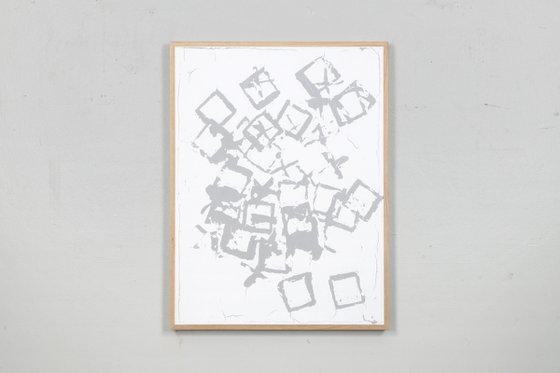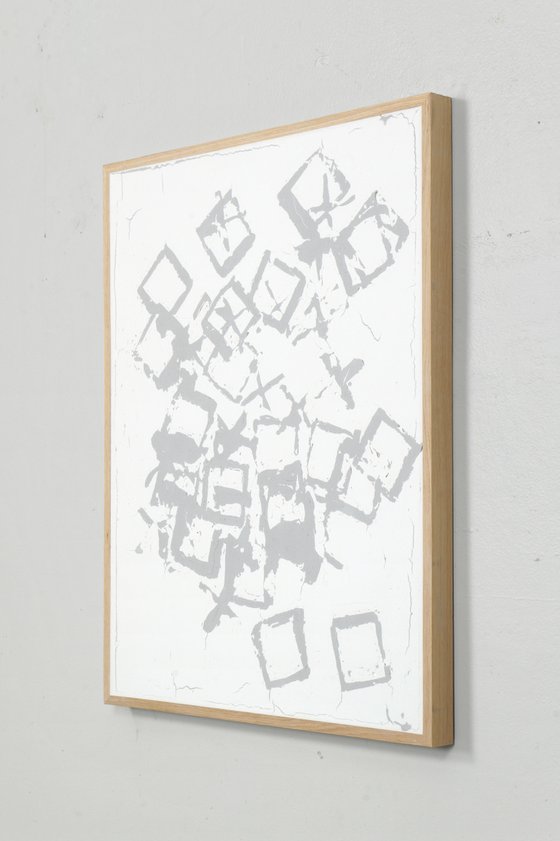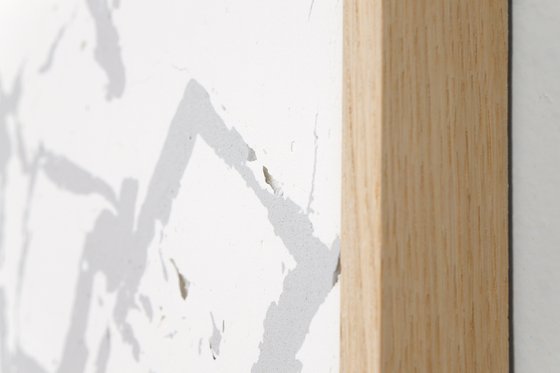- By medium
- By subject
- By budget
- Sales
- Gift cards
- Discover all art
- Artists
- Editors’ picks
- Ideas
Original artwork description:
64x84 cm | Filler, oak frame
This work is done by applying the squares and the x-s in an agitated manner. The energy level of the act replaced precision and cognitive choices. Even if the action was staged, the force projected in the documentation and the work's imprints is authentic.
An application always means submission to a relationship of power. The sender wants something that the recipient has or conveys. Checkboxes have the function in this context to neutralize or hide this fact. Instead of acknowledging the obligation that the position of power entails, one tries through a linguistic manoeuvre to rationalize one's own choice and transfer the responsibility to the applicant or external circumstances. Instead of performing the act of power a selection is, the selector's decision is reduced to a consequence of the choices the applicant he or herself has made. Not always getting what you want is a part of life. Still, rejection of an application based on checkboxes does not provide the authentic encounter that a semantic act expressed in the physical material can provide. A subjective, individually designed answer may not be fair, but precisely the uncontrollable sliding to which language is subjected when put into practice corresponds to the primordial irrational and contingent situation in which the subject always finds itself. On the contrary, the applicant's powerlessness is reinforced by the apparent rationality and "justice" the linguistic measurability of tick boxes shows. Thus, the therapeutic effect an authentic semantic encounter can give is denied.
Strong emotional expressions can overpower the subject's self-control. The rationality that emanates from the subject's linguistic constitution is suppressed, and a pattern of action with roots in a deeper and more diversified identity emerges. The Symbolic Order is a designation of the action and understanding horizon the individual has as a subject of language. To break this barrier and reach beyond what is perceived as possible, the subject must sometimes go beyond itself and use other languages and communication methods that transcend the atomized identity.
Tick Boxes
This is a series of works that use squares and crosses as compositional elements. The very components that constitute so-called checkboxes on questionnaires with prepared answer options. It is a tool for different types of surveys and application forms—systems for sorting people into different categories and maintaining various boundaries and constraints.
They are an essential part of an expanding neoliberal organisational culture where measurable results are crucial. Efforts are analysed against predetermined standards to increase economic efficiency. Language is trimmed for aesthetic qualities in favour of a strictly rational understanding. These works want to illuminate and challenge this trend by deconstructing one of its primary forms.
In the sense of psychoanalytic theory, the reduction of subjective content to simple categories, that tick-boxing implicates, is a shortcut in the process of symbolisation, i.e. to pull a statement from the Imaginary without transposing it properly through the Real, giving it a unique and individual materialisation. Even as language is instrumental to primordial alienation, it can also remedy this, but only if the symbolisation process is thorough and recognised.
Materials used:
Filler (coarse and fine) in oak frame
Tags:
#abstract #painting #minimalism #filler #oak frame#305 Application Form (Agitated Version) (2020)
Painting
by Johan Söderström
1 Artist Reviews
£1,021.72 Sold
- Painting on Panel / Board / MDF
- One of a kind artwork
- Size: 64 x 84 x 5cm (framed)
- Framed and ready to hang
- Signed on the back
- Style: Geometric
- Subject: Abstract and non-figurative
Do you like this artwork?
This artwork has sold, but the artist is accepting commission requests. Commissioning an artwork is easy and you get a perfectly personalised piece.
Original artwork description
64x84 cm | Filler, oak frame
This work is done by applying the squares and the x-s in an agitated manner. The energy level of the act replaced precision and cognitive choices. Even if the action was staged, the force projected in the documentation and the work's imprints is authentic.
An application always means submission to a relationship of power. The sender wants something that the recipient has or conveys. Checkboxes have the function in this context to neutralize or hide this fact. Instead of acknowledging the obligation that the position of power entails, one tries through a linguistic manoeuvre to rationalize one's own choice and transfer the responsibility to the applicant or external circumstances. Instead of performing the act of power a selection is, the selector's decision is reduced to a consequence of the choices the applicant he or herself has made. Not always getting what you want is a part of life. Still, rejection of an application based on checkboxes does not provide the authentic encounter that a semantic act expressed in the physical material can provide. A subjective, individually designed answer may not be fair, but precisely the uncontrollable sliding to which language is subjected when put into practice corresponds to the primordial irrational and contingent situation in which the subject always finds itself. On the contrary, the applicant's powerlessness is reinforced by the apparent rationality and "justice" the linguistic measurability of tick boxes shows. Thus, the therapeutic effect an authentic semantic encounter can give is denied.
Strong emotional expressions can overpower the subject's self-control. The rationality that emanates from the subject's linguistic constitution is suppressed, and a pattern of action with roots in a deeper and more diversified identity emerges. The Symbolic Order is a designation of the action and understanding horizon the individual has as a subject of language. To break this barrier and reach beyond what is perceived as possible, the subject must sometimes go beyond itself and use other languages and communication methods that transcend the atomized identity.
Tick Boxes
This is a series of works that use squares and crosses as compositional elements. The very components that constitute so-called checkboxes on questionnaires with prepared answer options. It is a tool for different types of surveys and application forms—systems for sorting people into different categories and maintaining various boundaries and constraints.
They are an essential part of an expanding neoliberal organisational culture where measurable results are crucial. Efforts are analysed against predetermined standards to increase economic efficiency. Language is trimmed for aesthetic qualities in favour of a strictly rational understanding. These works want to illuminate and challenge this trend by deconstructing one of its primary forms.
In the sense of psychoanalytic theory, the reduction of subjective content to simple categories, that tick-boxing implicates, is a shortcut in the process of symbolisation, i.e. to pull a statement from the Imaginary without transposing it properly through the Real, giving it a unique and individual materialisation. Even as language is instrumental to primordial alienation, it can also remedy this, but only if the symbolisation process is thorough and recognised.
Materials used:
Filler (coarse and fine) in oak frame
Tags:
#abstract #painting #minimalism #filler #oak frameReturns and refunds
We want you to love your art! If you are not completely satisfied with your purchase you can return it free within 14 days, no questions asked. Learn more







